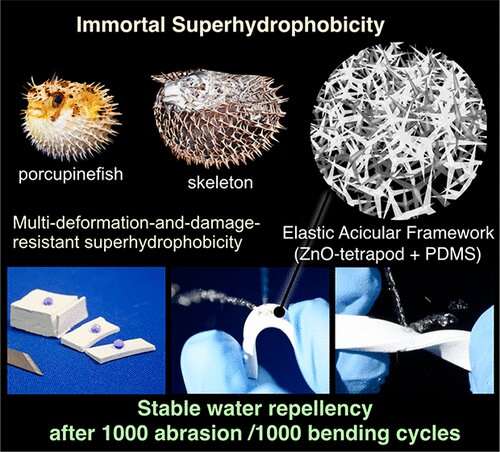Porcupinefish inspires sturdy superhydrophobic material

Nature has evolved a dazzling array of materials that help organisms thrive in diverse habitats. Sometimes, scientists can exploit these designs to develop useful materials with similar or completely new functions. Now, researchers reporting in ACS Applied Materials & Interfaces have made a durable and flexible super-water-repelling material inspired by spiky porcupinefish skin.
Superhydrophobic materials are extremely water repellent, causing droplets of water that fall on them to roll off or even bounce off. Such surfaces could be used for a variety of applications, such as self-cleaning, anti-icing and corrosion prevention. The materials typically owe their water repellency to tiny, needle-shaped structures on their surfaces. However, these micro- or nanotextured surfaces are fragile and easily damaged by bending. In addition, the prickly structures can be scratched or sliced off. Drawing inspiration from the spiny yet flexible skin of the porcupinefish, Yoshihiro Yamauchi, Masanobu Naito and colleagues wanted to develop a hardier superhydrophobic structure. Although porcupinefish skin itself is not superhydrophobic, fabricating the spines out of a hydrophobic compound and shrinking them down to the micrometer scale might make them so, the researchers reasoned.
To develop their superhydrophobic material, the team prepared microscale pufferfish-inspired scales made of zinc oxide. Then, to give the material elasticity, they added a silicone polymer, which combined with the spines to form a porous framework. The material, which could be molded into various shapes or coated onto other surfaces, was not only superhydrophobic but also highly flexible. Unlike other superhydrophobic materials, the porous structure retained its water repellency after being repeatedly bent or twisted. And because the structures existed throughout the material, not just on the surface, scratching or slicing didn't affect the material's repellency, either. The flexibility and porosity of the material helps cushion against mechanical impacts and deformation, the researchers say.
More information: Yoshihiro Yamauchi et al, Durable and Flexible Superhydrophobic Materials: Abrasion/Scratching/Slicing/Droplet Impacting/Bending/Twisting-Tolerant Composite with Porcupinefish-Like Structure, ACS Applied Materials & Interfaces (2019). DOI: 10.1021/acsami.9b09524
Journal information: ACS Applied Materials and Interfaces
Provided by American Chemical Society





















